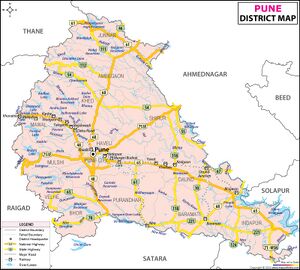Naneghat
| Author:Laxman Burdak, IFS (R) |

Naneghat (नाणेघाट) is a mountain pass in the Western Ghats range between the Konkan coast and the ancient town of Junnar in the Deccan plateau.
Location
The pass is about 120 kms north of Pune and about 165 kms east from Mumbai, Maharashtra, India.[1] The Naneghat Cave is near other important ancient sites. It is, for example, about 35 kms from the Lenyadri Group of Theravada Buddhist Caves and some 200 mounds that have been excavated near Junnar, mostly from the 3rd-century BCE and 3rd-century CE period.[2]
Variants
- Nanaghata नानाघाट, जिला पूना, महा., (AS, p.492)
- Naneghat (नाणेघाट)
- Nanaghat/Nana Ghat (IAST: Nānāghaṭ)
History
It was a part of an ancient trading route, and is famous for a major cave with Hindu Sanskrit inscriptions in Brahmi script.[3] These inscriptions have been dated between the 2nd and the 1st century BCE, and attributed to the Satavahana dynasty era.[4][5] The inscriptions are notable for linking the Vedic and Vaishnavism deities, mentioning some Vedic srauta rituals and of names that provide historical information about the ancient Satavahanas.[6][7] The inscriptions present the world's oldest numeration symbols for "2, 4, 6, 7, and 9" that resemble modern era numerals, more closely those found in modern Nagari and Hindu-Arabic script.[8][9]
The inscriptions are attributed to a queen of the Satavahana dynasty. Her name was either Nayanika or Naganika, likely the wife of king Satakarni. The details suggest that she was likely the queen mother, who sponsored this cave after the death of her husband, as the inscription narrates many details about their life together and her son being the new king.[10]
The Naneghat cave inscriptions have been dated by scholars to the last centuries of the 1st millennium BCE. Most scholars date it to the early 1st-century BCE, some to 2nd-century BCE, a few to even earlier.[11] [12]Sircar dated it to the second half of the 1st-century BCE.[13] Upinder Singh and Charles Higham date 1st century BCE.[14][15]
The Naneghat records have proved very important in establishing the history of the region. Vedic Gods like Dharma Indra, Chandra and Surya are mentioned here. The mention of Samkarsana (Balarama) and Vasudeva (Krishna) indicate the prevalence of Bhagavata tradition of Hinduism in the Satavahana dynasty.
नानाघाट
विजयेन्द्र कुमार माथुर[16] ने लेख किया है ...नानाघाट, जिला पूना, महा., (AS, p.492) नाणेघाट महाराष्ट्र के पुणे ज़िले में स्थित एक ऐतिहासिक स्थान और दर्रा है। इसके समीप एक गुफ़ा में सातवाहन नरेश शातकर्णि द्वितीय की रानी नयनिका (नागानिका) का एक अभिलेख है, जिसमें उसके द्वारा अश्वमेध, राजसूय यज्ञों सहित कई यज्ञ किये जाने तथा ब्राह्मणों को विभिन्न दान दिये जाने के उल्लेख हैं। यहाँ के अभिलेख में इन्द्र, संकर्षण, वासुदेव, चन्द्र सूर्य, यम, वरुण तथा कुबेर का देवताओं के रूप मे आह्वान किया गया है। इस अभिलेख में द्वितीय शताब्दी के लगभग बौद्धमत के उत्कर्ष काल के पश्चात् हिन्दू धर्म के पुनरुत्थान की प्रथम झलक मिलती है।
अभिलेख में शातकर्णि की सफलताओं और विजयों का वर्णन किया गया है उसे 'सिमुक वंश का धन'[17] कहा गया है। उसे 'अप्रतिहत चकदक्षिणापथपति' कहा गया है। पुष्यमित्र शुंग की भाँति शातकर्णि ने भी दो बार अश्वमेध यज्ञ का अनुष्ठान किया और ब्राह्मण धर्म के प्रति अपनी श्रद्धा प्रकट की। नाणेघाट का अभिलेख इस विषय का साक्ष्य प्रस्तुत करता है, जिसमें उसके लिए 'अश्वमेध यज्ञ द्वितीय इष्ट' कहा गया है। नाणेघाट के अभिलेख से यह भी ज्ञात होता है कि शातकर्णि की मृत्यु के अनंतर उसकी रानी नायानिका, जो अंगीय कुलीन महारथी त्रणकयिरो की दुहिता थी, उसने राजकार्य सम्भाला। उसके दो पुत्र 'शाक्तिश्री' और 'वेदश्री' अभी अल्पवयस्क थे, अत: रानी ने उनकी संरक्षिका के रूप में शासन की बागडोर सम्भाली।
External links
References
- ↑ Georg Bühler (1883), Report on the Elura cave temples and the Brahmanical and Jaina caves in western India (Chapter: The Nanaghat Inscriptions), Archaeological Survey of India, pp. 53-54.
- ↑ Lenyadri Group of Caves, Junnar, Archaeological Survey of India
- ↑ Theo Damsteegt (1978). Epigraphical Hybrid Sanskrit. Brill Academic. p. 206
- ↑ Richard Salomon (1998). Indian Epigraphy: A Guide to the Study of Inscriptions in Sanskrit, Prakrit, and the other Indo-Aryan Languages. Oxford University Press. ISBN 978-0-19-535666-3. p. 144.
- ↑ Upinder Singh (2008). A History of Ancient and Early Medieval India: From the Stone Age to the 12th Century. Pearson Education. ISBN 978-81-317-1120-0.pp. 381-384.
- ↑ Upinder Singh 2008, pp. 381-384.
- ↑ Carla Sinopilo (2001). Susan E. Alcock (ed.). Empires: Perspectives from Archaeology and History. Cambridge University Press. ISBN 978-0-521-77020-0.pp. 168-169.
- ↑ David E. Smith (1978). History of Mathematics. Courier. ISBN 978-0-486-20430-7.pp. 65-68.
- ↑ Norton, James H. K. (2001). Global Studies: India and South Asia. McGraw-Hill. ISBN 978-0-07-243298-5.pp. 175-176.
- ↑ Upinder Singh 2008, pp. 381-384.
- ↑ Richard Salomon 1998, p. 144.
- ↑ Upinder Singh 2008, pp. 381-384.
- ↑ D.C. Sircar (1965), Select Inscriptions, Volume 1, University of Calcutta, p. 184.
- ↑ Upinder Singh 2008, pp. 382-384
- ↑ Charles Higham (2009). Encyclopedia of Ancient Asian Civilizations. Infobase Publishing. p. 299. ISBN 9781438109961.
- ↑ Aitihasik Sthanavali by Vijayendra Kumar Mathur, p.492
- ↑ सिमुक सिमुक सातवाहनस वंशवधनस्

